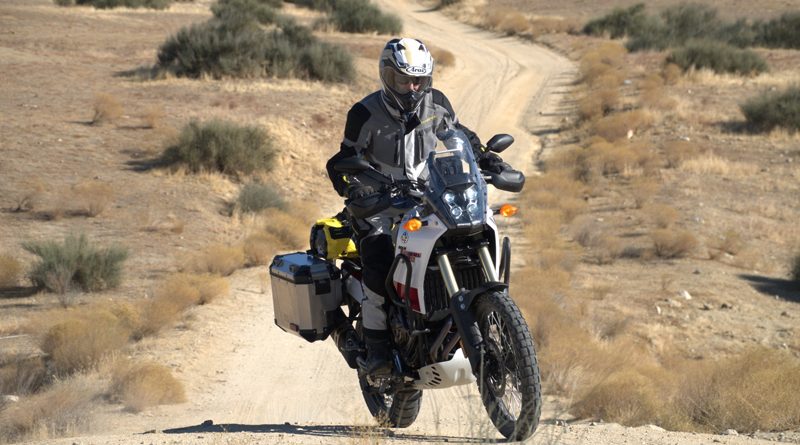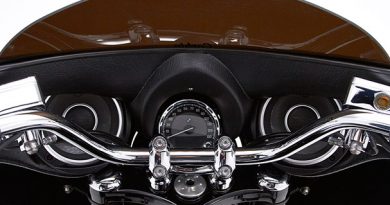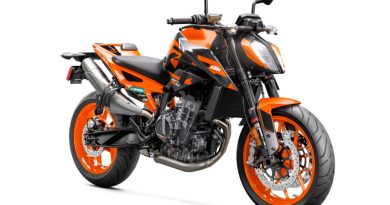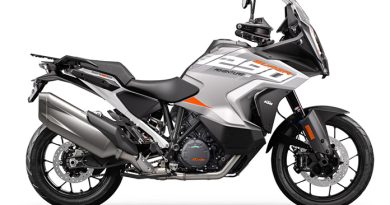2021 Yamaha Ténéré 700 | Tour Test Review
Based on Kevin Wing’s first ride on the all-new 2021 Yamaha Ténéré 700 (Rider, August 2020 and on ridermagazine.com), I knew the T7 worked quite well, wherever one chooses to ride it. With more than 65,000 adventure-heavy miles on my 2009 BMW F 800 GS, I’m looking for a newer replacement and the T7 could be it. When I was offered one equipped with a host of Yamaha accessories for a long-term test, I jumped at the chance.
Off I went, into the desert and around California’s Central Coast, to check out the T7 when it’s dressed up, loaded down and ready to roam. After 3,000 miles of mixed riding — everything from fast freeways to wide-open desert roads, twisty canyons and off-pavement excursions — I’m impressed. My rear end, not so much. Initially comfortable, the narrow seat became a pain in the butt after a few hours.
The first add-on was Yamaha’s heavy-duty Main Stand ($364.99; shopyamaha.com). With a spot-on balance point, the centerstand elevates the rear wheel while keeping the front end easy to lift, simplifying chain maintenance and flat repairs. Given the T7’s tubed tires, there’s no plug-and-go option.
Before hitting the road, I packed my gear into Yamaha’s Aluminum Side Cases, which hold 37 and 35 liters of gear on the left and right sides, respectively ($519.99 each, plus $30.99 per lock assembly; the $499.99 Side Case Mount is also required). While that’s sufficient volume for motel touring, campers may need to strap on a bag. I prefer a rack plate for that, but the pannier racks aren’t designed for one, nor for a top box. Made of tubular steel, the racks seem strong enough for an additional load. They provided attachment points for the Rok straps that held my Touratech dry bag tight to the pillion while skittering over desert washboard and banging through wheel-swallowing potholes. The side cases are keyed to the ignition and lock onto the rack as well as locking closed, or you can travel with them unlocked and semi-latched. Attaching and dismounting the boxes, which widen the T7 by four inches, is child’s play. All that’s missing is a set of liners to prevent the bare aluminum interiors from turning your gear black.
After miles of mulling it over, it seems the T7’s monochrome LCD digital instrument panel needs a rethink. Speed, clock, gear position, tachometer and fuel get dedicated space, while eight other values compete for a single line on the screen, scrolled through by buttons on the unit or a handlebar switch. Less scrolling would leave more time to watch the road. Fuel management is critical when touring, no more so than when gas stations are scarce, so I watched the six-bar fuel gauge like a hawk. The first bar stays up for 70 miles or so, and the next four remain for 20-plus miles each before the last bar standing starts flashing to indicate low fuel. Per the owner’s manual, this means 1.1 gallons remain. On my desert run I rode 50 miles with it blinking, and could have squeaked out 14 more based on the average mileage the T7 reported. Once I realized how pessimistic it is (my bad for not reading the manual earlier), the flashing icon went from anxiety-producing to mere irritation. Overall, the T7 returned 50.5 mpg, for a range of 212 miles, and my hand-computed mileage was 3-5 mpg better per tank than the bike’s display.
The Ténéré is no slouch when it comes to fast cruising and passing cars, proving itself capable and comfortable at the supra-legal highway speeds I maintained to keep up with traffic. For a motorcycle that feels light from the moment you throw a leg over, it showed real poise when fighting heavy crosswinds. What goes fast must slow down, so it was comforting that the T7’s brakes are up to the task with the bike loaded. Several panic stop tests from 60 mph on a deserted stretch of Route 66 proved the point. Though ABS on is by default, defeating it for off-pavement riding takes only a button push while stopped.
My first dirt experience with the T7 was a few miles of sloped, sandy two-track — at night. While the bevel-edged panniers fended off spiny cholla cactus and sharp yucca, the T7’s four-LED stacked headlight shined bright, wide and far. The CP2 engine’s strong low end and linear power delivery let me putt along in second gear in tight terrain without fearing a right-wrist twitch would send me sideways. The clutch is easy to modulate through the slippery stuff, though the reach on the non-adjustable lever is a bit far for my hand. On wide-open dirt roads, the T7 was rock-steady, and a hoot to pitch into the turns. Credit the 50/50 Pirelli Scorpion Rally STR tires, which were smooth, grippy and fun on pavement and hooked up well when it ended.
Yamaha’s Engine Guard ($329.99) took on extra significance as I prowled the desert, where I’ve seen the smoothest dirt road suddenly turn nasty with ruts or rock gardens. Welded from tubular steel and crinkle-coated black, the guard mounts to the frame and engine, with a front crossbar providing compression support. Standing ready to handle whatever nature dishes out, they would also make good mounting points for auxiliary lights.
Yamaha’s Universal Grip Heaters ($119.99) use an integrated design that locates a four-position switch and indicator lights adjacent to the left handgrip. They were a welcome addition when temperatures dropped into the 40s and 50s, but grip heat was underwhelming on any setting except high, and the right grip was notably warmer than the left. A 12-volt outlet in the cockpit supports heated clothing or charging electronics mounted on the handlebar or on the crossbar above the instrument panel.
Rather ride than wrench? The T7 has you covered with dirt-simple routine maintenance. Remove four bolts to drop the skid pan, and you’ll find the oil filter and drain plug right up front. A sight glass simplifies checking the oil level. And, bless that centerstand, chain adjustment is just as easy, but bring your own 27mm wrench for the rear axle nut. Both rebound and compression damping on the front and rear suspension are accomplished with a flat-blade screwdriver, and a twist of the knob on the rear shock adjusts preload.
In my local mountains or out in the desert, on pavement or off, the T7 has been an excellent partner for exploration, corner carving and flat-out movin’ down the road. Notable was how well the small windscreen kept both buffeting and noise at bay under most riding conditions. Even the mirrors are good, giving a wide, clear view with minimum blur. I had zero problems with any of the accessories, and enjoyed the convenience, comfort and peace of mind they provided. Factory parts means no hassles with fit, plus an integrated look and feel. As a group they added 51 pounds to the standard T7, for a total of 511 pounds fully fueled. There are still some things that would make this bike better for adventuring, like real hand guards and a beefier skid pan, so stay tuned while we set about customizing an already capable adventure machine.
2021 Yamaha Ténéré 700 Specs:
Website: Yamaha Motor USA
Base Price: $9,999
Engine Type: Liguid-cooled, transverse parallel twin, DOHC, 4 valves per cyl.
Bore x Stroke: 80.0mm x 68.6mm
Displacement: 689cc
Transmission: 6-speed, cable-actuated wet clutch
Final Drive: O-ring chain
Wheelbase: 62.8 in.
Rake/Trail: 27.0 degrees/4.1 in.
Seat Height: 34.6 in.
Claimed Wet Weight: 452 lbs.
Fuel Capacity: 4.2 gals., last 1.1-gal. warning light on
MPG: 86 octane min (high/avg/low) NA
2021 Yamaha Ténéré 700 Photo Gallery:


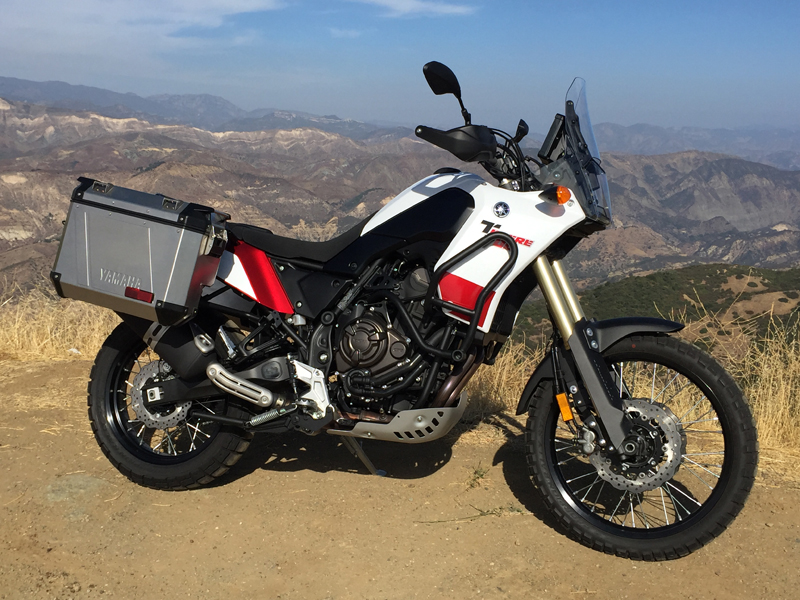









The post 2021 Yamaha Ténéré 700 | Tour Test Review first appeared on Rider Magazine.

